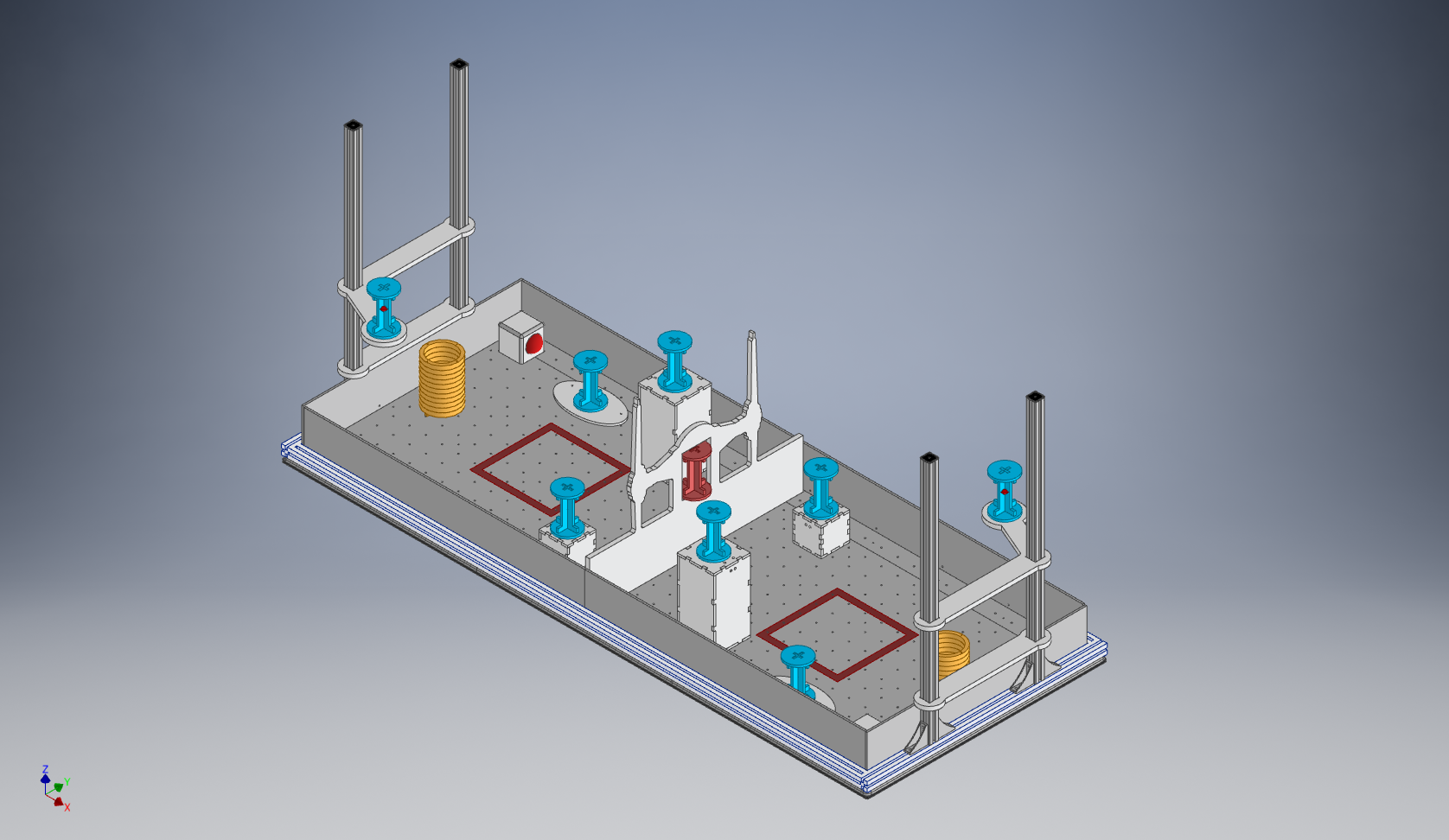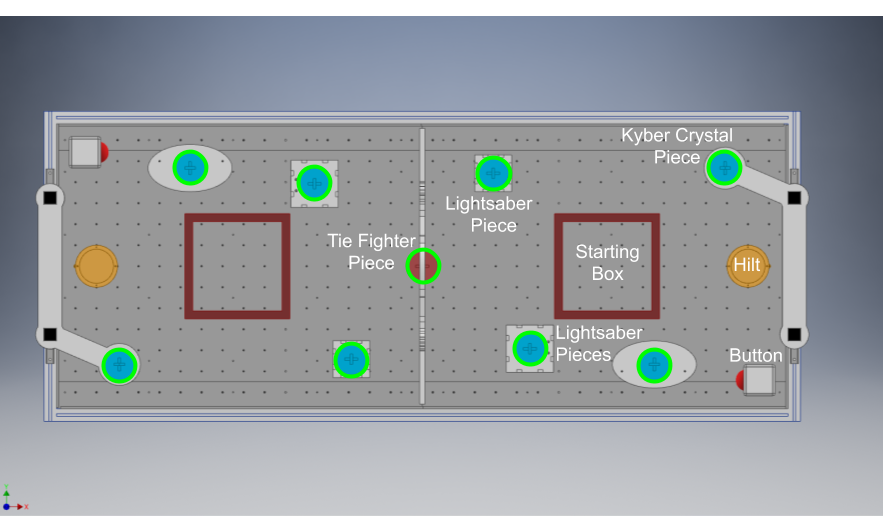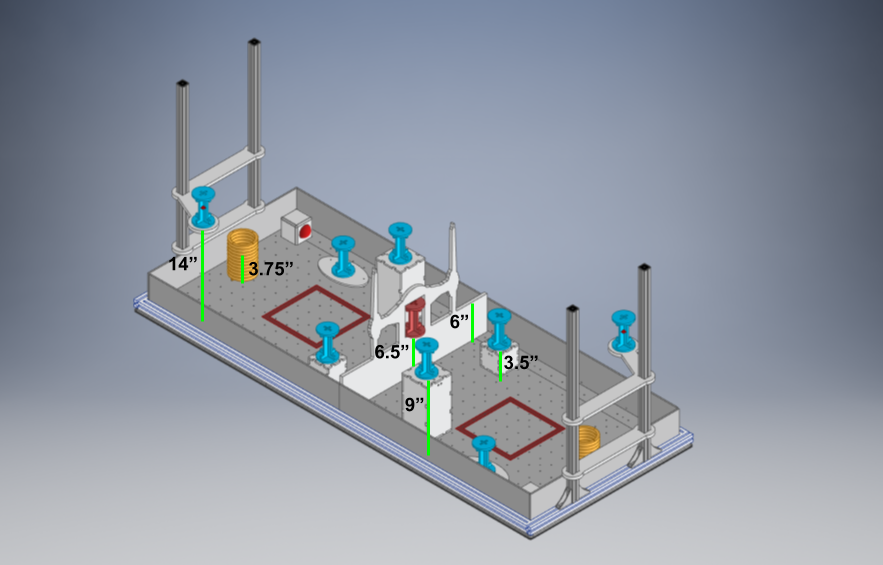MAE WARS The Rise of Morimoto
Congratulations Padawan! The time has come for you to build your lightsaber! If you do it well we may even grant you the rank of Master...
If you build your lightsaber with careful balance, it will serve you well for many years. Build it hastily and it can crumble in mere seconds. Outpace your opponent to win the attention of the jedi council.
MAE 3 students will design robots to gather lightsaber pieces scattered across the galaxy (contest table), and stack them up to form their lightsaber. As the difficulty of balancing the pieces increases, the point value also increases!
60 Second Competition: Two robots will compete head-to-head for sixty (60) seconds. Robots will try to score as many points as possible, by stacking pieces higher, by including special pieces, and by turning on their lightsaber to prove their craftsmanship. All scoring will be done at the completion of the contest after all parts have finished moving. The pieces are spread throughout the field, as shown in the following pictures.
Scoring:
Each side of the field has 3 normal lightsaber pieces, plus one kyber crystal piece. In addition, there is a "tie fighter" piece in the middle of the field. These pieces can be used to build your lightsaber, by stacking them end-to-end in your hilt. Lightsaber pieces must be stacked end to end to earn points. If you include a kyber crystal in your lightsaber, it can be turned on for extra style, honor, glory, and points. Your lightsaber must be free standing or the council will be very displeased, will cut your points in half, and won't grant you the rank of master. The base layer of your lightsaber is worth one point, and each successive layer is worth one more than the layer below it. ie. the higher layers are worth more. The kyber crystal piece is worth the same as a normal piece, but if you include it in your lightsaber you will be able to turn it on. Turning on your lightsaber is worth 2 points. The tie fighter piece is worth twice as much as a normal piece. In the case of a tie, the team with the tie fighter piece on their side wins.
Some example scoring tables
The Starting Boxes and Climbing the Wall: Robots must fit entirely within a 10x10x10in starting box at the start of the competition, but can be located in any position within the team's half of the field so long as no part of the starting box is touching any object on the contest table (including the side walls and any lightsaber pieces) when placed over the robot. If any part of your robot is touching a surface outside your half of the field at the end of the match, you will suffer a 5 point penalty.
Tie Breakers: In the event of a tie, the first tiebreaker will be possession of the Tie Fighter. Whichever team has the Tie Fighter on its side of the table will be the winner. Note that the Tie Fighter must be fully dislodged from it's starting location. If the Tie Fighter has not been dislodged from its starting
position, then the second tiebreaker will be settled in a duel of rock paper scissors. Actual Photos:
COMING SOON
General MAE3 Competition rules:
A complete list of rules is provided at the end of this document, and any clarifications to the rules will be posted at the end of this webpage throughout the quarter. However, some key rules are: ● Robot setup time on the contest table cannot exceed 2 minutes. ● Manufacturing variations will exist between playing fields. It is the team's responsibility to design a robot that will work on all contest tables. ● Each robot must only be built out of kit parts provided. ● Robots must be built in the Design Studio only using Design Studio tools. ● The disassembled robot must be able to fit in the team's locker, where it must be stored. ● Robots may be designed to interact. However, it is not in the spirit of the competition to intentionally damage another machine and no part of the kit may be used in a manner that is intended to cause harm. Any device which is designed to chop, break, or penetrate another machine will not be allowed to compete. If you think your machine may be at risk for violating this rule, ask early before you build it! o Applying forces onto an opposing team’s robot that are large enough to break plastic parts, while the opposing robot is in its starting area, will be deemed to be intentional harm to an opponent and can lead to disqualification. o However, blocking other robots or pushing other robots while attempting to score will generally be considered legal. ● Robots will compete in a head-to-head competition. However, operation of the robot without an opponent will be an important part of the robot grade. ● If any part of your robot is touching a surface outside your half of the field at the end of the match, you will suffer a 5 point penalty ●
If any part of your robot is touching the pieces of your lightsaber at the end of the match, your point value will be cut in half ● Lightsaber pieces must be stacked end-to-end to earn points ● Only lightsaber stacks in the hilt contribute to points -- if you stack pieces elsewhere, they don't give you points
The robots must be powered solely from electrical power transferred through the power cord, and from potential energy stored in the robot at the start of the contest. The kit includes 2 geared DC motors, 3 non-geared DC motors, and one solenoid. Electrical power will be provided from a power supply with a maximum of 5VDC output. The power will be controlled by the following switches: Two Fixed 5 Volt DC switches Two Variable Voltage switches (0 to 5VDC) with a user-controlled knob to adjust the voltage. Each switch is Double Pole Double Throw (DPDT) switches, which can operate a DC motor in either direction. Note the kit contains five DC motors and one solenoid, but only four user-controlled switches. More than one electrical device can be connected to a single switch, but the voltage may drop if a large current draw is placed on the power supply. Use of motors, solenoids, and switches will be covered in lecture and is described in the course pack. Review the Power Supply and Multimeter Use carefully. Issues with the electrical power often occur with the Variable Voltage switches, since the maximum current output is less in these switches. The non-geared motors draw high current and startup problems may occur if multiple non-geared motors with high loads are tied to the variable voltage source!
Each machine must be constructed solely from materials provided in the Kit Parts list (List attached below). Some key points on these guidelines are: ● No foamcore in final robot (as stated in kit parts list). ● The wire and string are “serve-yourself”, but are limited in length as noted. ● The paper cover on the acrylic parts is not to be used as a separate part. If it is detached from the acrylic, it must be discarded. In addition to the kit parts listed in the table, the following items may be included in the machine: ● Nuts, bolts, and washers included in the Design Studio bin. These include bolts from size 2 to size 10, and metric screws for mounting the motors. ● Only take nuts and bolts from the bin as you need them, and search through the spare bolt bin before taking more (we went through $1,500 in fasteners last year!). ● Adhesives; including hot melt glue, and acrylic adhesive. ● Tape used ONLY for electrical insulation. ● Lubricants used only to reduce friction within one's machine (not on the contest table). ● Nonfunctional decorations. Replacement Material Policy We have some extra material that can be used for experimentation. This material will be made available in the lab scrap bins. In addition, each section tutor has access to a limited amount of replacement material for their section. If you need replacement parts, contact your tutor. Some replacement of "mistakes" made to kit parts will be available, but supplies are limited, and replacement is not guaranteed.
3D Printed Parts See 3D printing page for complete rules: https://sites.google.com/a/eng.ucsd.edu/mae3/3d-printing
Each team may have parts made in the Design Studio's 3D printers under the following guidelines. ● The combined volume of all 3D printed parts may not exceed 50 cubic inches per team. ● Individual prints must fit within a 4x4x4in cube. ● Team members must create the CAD files for all 3D printed parts, except for gears, timing belt pulleys, and selected parts that will be posted on the MAE3 webpage. ● Teams can experiment with 3D printing and parts that are not used on the robot will not count towards the team's total. However, priority to the 3D printer will go to students working during their section time and to teams which have not yet used to 3D printer as much. Use of the 3D printer may be heavy during the final weeks of the class, so do not count on readily available access at that point.
The energy used by the devices in the competition must come solely from:
Umbilical Cables The electrical connections will made to a single umbilical cord hung from above the table; one on each side of the table. The umbilical cord cannot be touched during the contest, and there will be some drag from the cable. Each machine must be designed to overcome this drag as needed for motion of the machine. If requested, a TA can ensure that the umbilical cable does not snag.
The grade for the project will not be adversely affected by poor performance in the contest, but will be based upon:
A trophy will be presented to each member of the winning teams, and a number of machines will be selected for display in the Design Studio. Team members must work out among themselves who will keep the final machine (after their display period). Teams will post presentations and video of their robot on the class web page, which they can cherish forever.
Only the tools and machine equipment in the Design Studio can be used to build the robot.
|
Robot Contest >





